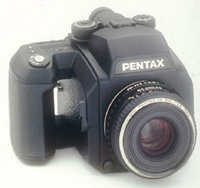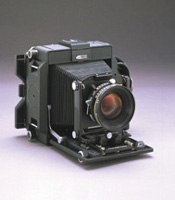Medium Format Update
Breaking News And Highlights
| Medium format cameras are becoming more automatic, have more lens choices, and are becoming sexier, too. All this is an attempt by medium format system manufacturers to lure advanced 35mm users into their fold and to convince pros that upgrading is in their best interest. There has always been talk of bringing advanced 35mm users into the medium format realm; now, there's a "downward" migration as well, with more large format users making medium format their choice. There's little question that a medium format negative or slide has advantages over the smaller 35mm and even digital SLRs, a fact well understood by pros. Portrait and wedding, fashion and commercial, and even sports photographers choose medium format as their medium for many of their jobs. Those who earn their living in other ways but who demand the advantages of a larger format also work with these cameras. That's because many medium format cameras now offer perspective control as well, without the bulk of the larger format systems. |
|
Pentax 645NII The 6x4.5 format gives you the best of both worlds. Generally, cameras of this genre are a good compromise between 35mm weight and portability and larger film advantages. And their rectangular frame allows for vertical or horizontal framing in the finder and less cropping when you go for standard print aspect ratios. Although this report does not allow for a full field inspection of this new camera (we eagerly await a test sample), here's a quick rundown of some of the features. We start with a rugged design and body construction. The 645NII's body is made of rigid aluminum die cast and protected with a glass-fiber reinforced polycarbonate coating. Pentax says that special mechanisms have been incorporated to ensure low-noise, low-shock operation. |
|
The autofocus system is the proven Pentax SAFOX IV phase-matching type that is said to operate down to EV -1; in other words, it operates in quite dim light. There's a choice of a wide three-point AF or Spot AF frame with three focus modes--Manual, Continuous, or Single. In Continuous, there's even Predictive AF, which is great for moving subjects. The exposure modes are the usual suspects, being Programmed AE, Shutter- and Aperture-Priority, and Manual. The metering system is the Dual Six Segment multi-pattern type found in the 645N, with options for Spot and Center-Weighted Averaging. There's also autobracketing, AE compensation, and AE lock as well. If you want to check on your exposures the 645NII can imprint data onto the bottom of the film outside the image area. This is not a new feature, but there are additional functions, such as the number of film rolls, focusing mode, ISO, AE lock or bracket indication and flash sync. The good news for those wanting to upgrade from their 645N or add this as a second body is that all current 645N lenses (SMC-Pentax FA 645) can be used. The camera powers up with six AA batteries, alkaline or lithium, or can be kept going with the optional Battery Pack 645. |
|
New Pentax Lenses |
|
Hasselblad Lens Additions |
|
Bronica RF645 The RF645 has a maximum shutter speed of 1/750 sec (using Program AE with f/8 maximum aperture), a dedicated flash (the RF20), and Aperture-Priority as well as Manual exposure modes. You can work with slow sync in Aperture-Priority mode or use Program AE to ensure that the flash speed doesn't go below 1/60 sec. This manual advance camera has a vertical orientation in the viewfinder and one of the best information and framing finders we've seen. The price is around $2132 with the 65mm f/4 lens. |
|
Linhof M679cc |
|
Horseman SW612/SW6x9 |
|
Rollei's 6008 AF |
|
Kodak DCS Pro Back Update For example, Product Hi Color makes bright colors even more highly saturated and does not affect lightly saturated colors. With Portrait Hi Color bright colors become more saturated and skin tones are more intensified. To hold skin tones you would choose Hi Color Hold, which also intensifies saturated colors. In essence, you can mix and match as desired. |
|
Fuji Luma Digital Back Promo |
|
Mamiya And Leaf C-Most |
|
Contax 645 |
|
Phase One Affordable Options Phoenix offers a range of twin lens reflex cameras that are similar in design to the vintage Rollei TLR models. The 4A-107G has a between the lens shutter in a range of 1 sec to 1/300 sec, plus B, and has sync at all shutter speeds. The integral lens is a 75mm f/2.8 (with three elements in three groups). The folding waist-level finder has a focusing magnifier built in. Check the Phoenix web site for information on their full line-up of these very practical cameras. Manufacturers/Distributors |
- Log in or register to post comments














































